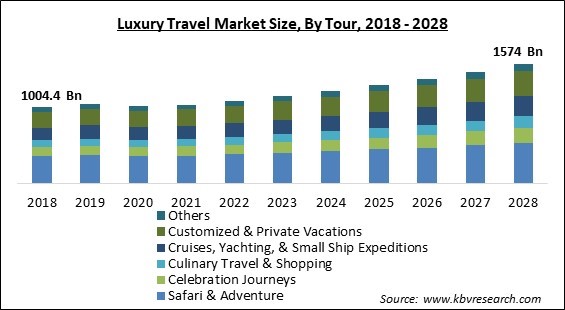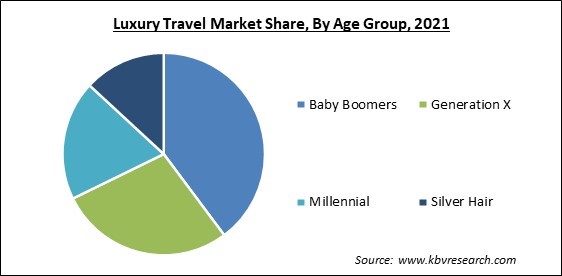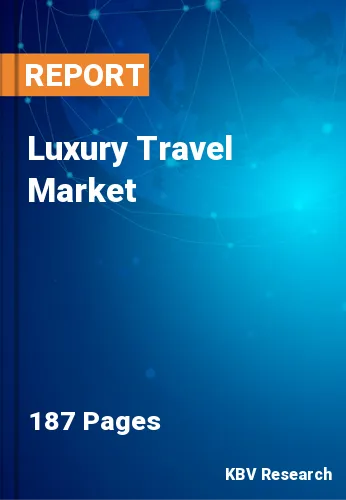The Global Luxury Travel Market size is expected to reach $1,574 billion by 2028, rising at a market growth of 6.3% CAGR during the forecast period.
Exclusive and one-of-a-kind experiences, and highly individualized services, are linked with luxury travel. The sector is being driven by rising expenditure by affluent tourists who want to see undiscovered places and have novel experiences. The industry has been developing as a result of the rising trend of short vacations as well as the worldwide expanding tourist industry.

Given that spending on art, restaurants, culture, guides, and athletic events by luxury travelers is essential to the local economies of the places they visit, luxury travel plays a significant role in the distribution of wealth around the world. Travelers are searching for flexible schedules that combine entertainment and relaxation in order to build their own special experiences.
Numerous tourists, especially wealthy ones, are drawn to the growing popularity of cruises, yachts, and small ships. One of the most prominent customers in this market is thought to be High Net Worth Individuals (HNWIs). As a result, businesses in the sector have been focusing more on luxury water-based travel, like cruises.
Additionally, the prevalence of internet research has grown dramatically over time. During the forecast period, high-tech (smart) rooms are expected to fuel demand for luxury lodging and travel, offering guests total control over how they use their accommodations and choose to travel. The industry is expanding as a result of rising internet usage and the availability of social media. Also, the number of travel tales shared on social media sites like Instagram, Facebook, and blogging platforms has multiplied.
Worldwide, the COVID-19 pandemic has had an impact on every industry. Around the world, the tourism sector has been severely impacted, which has a negative effect on its related industries, including travel agencies, hospitality, tour operators, and all types of transportation services. The remaining people stayed at home out of dread of the virus itself, while almost the whole world's population adjusted to their way of life under various travel limitations. As a result, the tourism industry virtually stopped.
Regarding VISA policies, each nation has its own distinct set of guidelines for visitors of various nationalities. Governments are, however, more frequently forcing tourists to get travel insurance in order to get a VISA. To visit countries like France, the United States, Norway, Belgium, Luxembourg, Finland, and Poland, among others, one must have travel health insurance. This clause exists to make sure that visitors are adequately covered in the case of a medical emergency due to the high costs of medical care and hospitalization in the host nations. The travel and tourism business has consistently grown during the past ten years.
Every element of our life, including the way we consume, has been altered by social media. Businesses have been profoundly impacted by these advances, mostly because they have made new marketing methods possible. Undoubtedly a component of all of these is tourism, one of the most dynamic economic sectors in the world. People are now encouraged to talk about their travels. Social networking has changed how people make decisions as a result.
The travel sector has been almost paralyzed by the pandemic. The COVID-19 pandemic has had an effect on the tourism sector because of the resulting travel restrictions and decline in demand from tourists. The spread of the coronavirus has had a significant impact on the tourist sector because several nations have imposed travel restrictions in an effort to stop it.

Based on tour, the luxury travel market is segmented into customized & private vacations, safari & adventure, cruises, yachting & small ship expeditions, celebration journeys, culinary travel & shopping and others. The culinary travel & shopping segment acquired a substantial revenue share in the luxury travel market in 2021. The main goals of culinary travel are to learn about local cuisine and culture while enjoying the local specialties. Cooking lessons, beer, historical culinary routes, wine, and spirits trails, food fairs, and festivals, and exploratory tours of food plants and processing facilities are all activities that tourists are taking part in.
On the basis of age group, the luxury travel market is fragmented into millennial, generation X, baby boomers and silver hair. In 2021, the baby boomers segment held the largest revenue share in the luxury travel market. The people of this age have the time, money, and desire to travel, visit a number of exciting locations, and check off a variety of items on their bucket list, such as going on a luxury cruise around the world, having a lengthy vacation on a cruise ship, and visiting exotic ports. These elements hasten segment growth in the upcoming years.
| Report Attribute | Details |
|---|---|
| Market size value in 2021 | USD 1037.4 Billion |
| Market size forecast in 2028 | USD 1,574 Billion |
| Base Year | 2021 |
| Historical Period | 2018 to 2020 |
| Forecast Period | 2022 to 2028 |
| Revenue Growth Rate | CAGR of 6.3% from 2022 to 2028 |
| Number of Pages | 187 |
| Number of Tables | 304 |
| Report coverage | Market Trends, Revenue Estimation and Forecast, Segmentation Analysis, Regional and Country Breakdown, Companies Strategic Developments, Company Profiling |
| Segments covered | Tour, Age Group, Region |
| Country scope | US, Canada, Mexico, Germany, UK, France, Russia, Spain, Italy, China, Japan, India, South Korea, Singapore, Malaysia, Brazil, Argentina, UAE, Saudi Arabia, South Africa, Nigeria |
| Growth Drivers |
|
| Restraints |
|
Region wise, the luxury travel market is analyzed across the North America, Europe, Asia Pacific and LAMEA. In 2021, the Europe region led the luxury travel market by generating the maximum revenue share. Even the most isolated regions of Europe are now more available to luxury visitors because of improved travel connectivity and the quick uptake of high-speed internet. This is encouraging people to travel to new, exotic places throughout the region, which is fostering the market growth there.
Free Valuable Insights: Global Luxury Travel Market size to reach USD 1,574 Billion by 2028
The market research report covers the analysis of key stake holders of the market. Key companies profiled in the report include TUI Group, Lindblad Expeditions Holdings, Inc., Thomas Cook (India) Limited (Fairfax Financial Holdings Limited), Scott Dunn, Abercrombie & Kent USA, LLC, Exodus Travels Limited, Travel Edge, Inc. (Navigatr Group), Butterfield & Robinson, Inc., Geographic Expeditions, Inc. and Micato Safaris.
By Tour
By Age Group
By Geography
The global Luxury Travel Market size is expected to reach $1,574 billion by 2028.
Travel Guidelines and Rules are driving the market in coming years, however, Rising cases of chronic diseases restraining people to travel restraints the growth of the market.
TUI Group, Lindblad Expeditions Holdings, Inc., Thomas Cook (India) Limited (Fairfax Financial Holdings Limited), Scott Dunn, Abercrombie & Kent USA, LLC, Exodus Travels Limited, Travel Edge, Inc. (Navigatr Group), Butterfield & Robinson, Inc., Geographic Expeditions, Inc. and Micato Safaris.
The expected CAGR of the Luxury Travel Market is 6.3% from 2022 to 2028.
The Safari & Adventure market is leading the Global Luxury Travel Market by Tour in 2021; thereby, achieving a market value of $532.9 Billion by 2028.
The Europe market dominated the Global Luxury Travel Market by Region in 2021; thereby, achieving a market value of $505.1 Billion by 2028.
Our team of dedicated experts can provide you with attractive expansion opportunities for your business.

